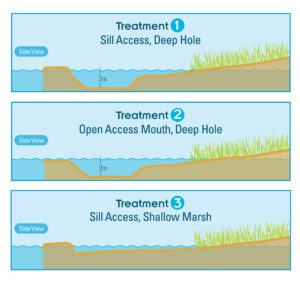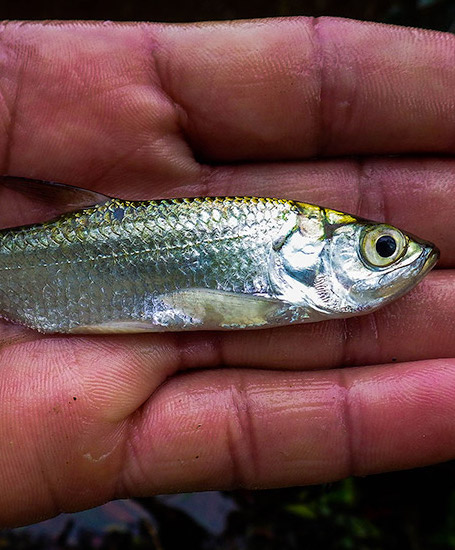Juvenile tarpon depend on mangrove backwater wetlands and creeks as nurseries. Without such habitats, few juveniles would survive to become adults. Unfortunately, mangroves are in decline worldwide: globally, approximately 35 percent of mangroves have been lost, and continue to be lost at a rate of 2 percent per year; in Florida, approximately 50 percent of mangroves have already been lost, and degradation of these habitats continues. The past and ongoing loss of juvenile tarpon nursery habitats is a major reason that a recent International Union for the Conservation of Nature scientific assessment classified the tarpon population as “vulnerable.”
Even when coastal mangroves and salt marshes are protected, which limits direct impacts from development, these habitats continue to be affected by inland problems. One contributing factor is nutrient runoff from roadways and lawn fertilizers that feed harmful algae blooms. Another issue is the disruption to natural freshwater flow patterns caused by inland hydrologic modification, such as ditching and stormwater retention ponds, which disrupts the flow of freshwater to estuaries and degrades the habitat quality of the adjacent mangrove and marsh habitats. Although many mangrove habitats don’t appear to have suffered direct damage (such as from clearing or dredging), the effects of upland habitat degradation on mangroves are just as damaging.
BTT is directly addressing the decline of juvenile tarpon habitat in Southwest Florida by applying scientific approaches to map existing habitat, restore degraded habitat, and enhance habitat protections.
Mapping Juvenile Tarpon Habitat
BTT began its Juvenile Tarpon Habitat Mapping Project in 2016, collaborating with anglers to identify nursery habitats harboring tarpon 12 inches or less and assessing them as natural or altered/degraded. Over 65 percent of the angler-reported habitats were classified as altered. This information is used by BTT to prioritize areas for restoration. This important habitat work is ongoing (contact us at info@bonefishtarpontrust.org if you would like to report a juvenile tarpon habitat).
Developing Nursery Habitat Designs

One way to address the loss of coastal habitat is to restore marginally degraded areas. To achieve this goal, BTT has collaborated with the Charlotte Harbor National Estuary Program (CHNEP), Southwest Florida Water Management District, and the Florida Fish and Wildlife Conservation Commission to develop three different nursery habitat designs in canals in the Coral Creek Preserve near Placida, Florida. The treatments BTT designed and tested at Coral Creek can be applied to other areas in need of restoration.
Each of the designs is intended to mimic a natural system.
- The first design features a sill mouth at the connection to the main canal which acts as a restrictive barrier during low tides. Restricted access excludes large predators from entering, but also allows juvenile tarpon to leave the nursery habitat during summer months, when water is high. The design also features a deep hole that provides a temperature refuge and hiding place from avian predators.
- The second design also includes a deep hole, but instead of a sill mouth, it has an open flowing connection that allows for continual fish passage. This will help BTT scientists to determine if preventing predator access is essential for productive nursery habitat, and if the ability move into open water is important for juvenile fish.
- The third design includes the sill mouth of the first design, but forgoes the deep hole and follows the topography of a meandering shallow creek. This treatment allows us to compare the importance of the deep hole as a necessary nursery habitat element.
BTT conducted surveys at Coral Creek, as the final step in this project. This included PIT tagging all captured juvenile tarpon, which enabled us to measure growth rates, estimate survival rates and abundance, and track tarpon movement throughout the various treatments. Data will provide us with a better idea of what juvenile tarpon need to thrive, and we’ll apply our findings to a list of priority sites for habitat restoration.
Nursery Habitat Restoration
BTT is working with the Florida Department of Environmental Protection to restore more than 1,000 acres of degraded mangrove wetlands in Rookery Bay National Estuarine Research Reserve (RBNERR), south of Naples, Florida. This project will restore tidal connections to mangroves that were disrupted by coastal development and roadways. Once reconnected, juvenile tarpon (and many other species) will have access to this important habitat.
Now, BTT is in the final design and permitting phase of two mangrove restoration projects at Shell Island Road and Marco Shores Lake in Rookery Bay. BTT and partners received a $250,000 grant from the National Fish and Wildlife Foundation, and BTT successfully advocated for an additional $250,000 of State funding to complete this current phase of the project.
Planning Future Restoration & Protection
Natural habitats are able to function as productive habitats for juveniles, so we need to prioritize them for protection. Degraded sites are in need of habitat restoration. But if we have a list of habitats, and not all locations can be protected or restored, how do we know where to start? By creating a Vulnerability Index (VI).
In 2023, BTT and partners received a NOAA RESTORE grant to conserve juvenile sportfish habitat in Charlotte Harbor, near the Tarpon Fishing Capital of the World – Boca Grande. A Vulnerability Index uses GIS mapping data layers for nursery habitat sites overlaid with data on things like current and potential development locations, freshwater flows, and whether land is publicly or privately owned to categorize areas as High, Medium or Low vulnerability. The VI will be provided to Charlotte County’s land use planning department. Once this VI is in place, we plan to expand to other regions in the state where sportfish nursery habitat is at risk.




